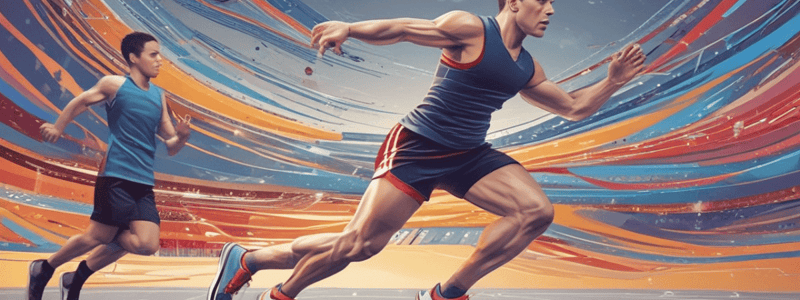Podcast
Questions and Answers
What is intermuscular coordination, and provide an example?
What is intermuscular coordination, and provide an example?
Intermuscular coordination refers to the ability of different muscles to work together to produce a coordinated movement. Example: Throwing a ball, which involves the coordination of shoulder, arm, and hand muscles.
What is intramuscular coordination, and provide an example?
What is intramuscular coordination, and provide an example?
Intramuscular coordination refers to the ability of individual muscles to produce a coordinated movement. Example: Curling a dumbbell, which involves the coordination of bicep motor units to produce elbow flexion.
What is neuromuscular coordination, and provide an example?
What is neuromuscular coordination, and provide an example?
Neuromuscular coordination refers to the interaction between the nervous system and muscles to produce a coordinated movement. Example: Riding a bike, which involves the coordination of neural signals to muscles to produce pedaling motion.
What is interindividual transfer, and provide an example?
What is interindividual transfer, and provide an example?
What is interlimb transfer, and provide an example?
What is interlimb transfer, and provide an example?
How do intermuscular coordination, intramuscular coordination, and neuromuscular coordination work together to produce a coordinated movement?
How do intermuscular coordination, intramuscular coordination, and neuromuscular coordination work together to produce a coordinated movement?
Flashcards are hidden until you start studying
Study Notes
Transfer Types in Physical Education
Intermuscular Coordination
- Refers to the ability of different muscles to work together to produce a coordinated movement
- Involves the integration of multiple muscles to achieve a specific movement pattern
- Examples:
- Throwing a ball: coordination of shoulder, arm, and hand muscles
- Kicking a ball: coordination of hip, knee, and ankle muscles
Intramuscular Coordination
- Refers to the ability of individual muscles to produce a coordinated movement
- Involves the activation of different motor units within a muscle to achieve a specific movement pattern
- Examples:
- Curling a dumbbell: coordination of bicep motor units to produce elbow flexion
- Straightening a knee: coordination of quadriceps motor units to produce knee extension
Neuromuscular Coordination
- Refers to the interaction between the nervous system and muscles to produce a coordinated movement
- Involves the transmission of neural signals to muscles to control movement patterns
- Examples:
- Riding a bike: coordination of neural signals to muscles to produce pedaling motion
- Playing a musical instrument: coordination of neural signals to muscles to produce finger movements
Interindividual Transfer
- Refers to the transfer of learning from one individual to another
- Involves the observation and imitation of movement patterns by one person from another
- Examples:
- A tennis coach demonstrating a serve to a student
- A gymnastics coach teaching a new skill to a team member
Interlimb Transfer
- Refers to the transfer of learning from one limb to another
- Involves the application of movement patterns learned with one limb to the other limb
- Examples:
- Practicing a tennis forehand with the dominant hand and then switching to the non-dominant hand
- Learning to shoot a basketball with the dominant hand and then switching to the non-dominant hand
Studying That Suits You
Use AI to generate personalized quizzes and flashcards to suit your learning preferences.




